Gielinorian God Wars
The Third Age, also known as The Age of War or more commonly referred to as the God Wars, was a time of great calamity in Gielinor. Although the God Wars themselves are not a part of the gameplay of Gielinor (except for the God Wars Dungeon), they are frequently referenced throughout the game and form the basis for many quests, characters, items, and locations.
All of the deities currently in this realm, and some who now are no longer with us, were involved in the war. Each took a faction, whether their own, or choosing to side with one of the stronger factions, until the only factions left were mine own and those supporting the hateful Zamorak. It was as things were building to a crescendo that the ancient Guthix, who had been unknown to us previously, stepped in and banished our combat from the lands. Sadly this has meant many of the issues over which we fought remain unfulfilled, but I blame not Guthix for his untimely intervention. If he had not interfered in our squabbles it is likely this world would have been scarred beyond repair, and I wish not for innocence to be the casualty of our war.
History

During the Second Age, Zaros had almost complete domination over the world. The areas that are now the Wilderness, Northern Misthalin, Northern Asgarnia and North-western Morytania formed the greatest part of his kingdom, and cities were constructed. When he was betrayed and defeated by his Mahjarrat general, Zamorak, the Second Age ended and the other gods began ruling without interference. However, many gods, especially Saradomin and Zamorak, wanted complete control.
During Ritual of the Mahjarrat, Saradomin states that Zamorak had returned from his banishment as he wanted to repossess the Stone of Jas, which Saradomin confiscated after Zamorak was banished.
After Zaros' banishment, Zamorak quickly rounded up Zaros' remaining loyalist followers and destroyed his fortresses and cities. The majority were destroyed quickly except for Senntisten, which held out for many hundreds of years. The war escalated as other Gods, seeing an opportunity, attempted to seize control of previously Zarosian areas. Zamorak was unable to efficiently conquer and maintain his holdings due to the speed with which he acted. The war further intensified, and by the time of the Fall of Hallowvale, almost the entirety of Gielinor was in chaos. The gods, at the time, could directly interact with the world, which caused destruction far beyond any that had been seen before or after the Wars.
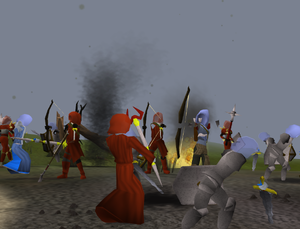
During the Wars, countless civilisations, races, and animal species disappeared. Many were destroyed, while others hid themselves or underwent drastic changes in order to survive. Much of the world itself was mutated; once healthy lands were ruined or reformed. Most of these changes were so devastating that they continue to affect Gielinor today.
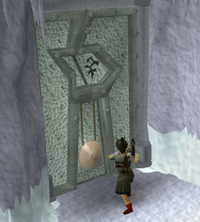
In fact, the entire world was on the brink of destruction when the fighting awoke Guthix from his sleep. At the end of the First Age, Guthix went into a deep slumber that stretched over many millennia. When he awoke, he found the world in ruin. He was so enraged that he instantly demanded that the gods stop fighting their wars on Gielinor, and to continue to hold influence only through their followers. Most of the gods left Gielinor, although they continued to watch over it and hear the prayers of their faithful. It was at this time that the Third Age, which had lasted approximately 4000 years, finally ended. Guthix planted a massive sword inscribed with mysterious letters into the crater of a volcano in the centre of the destroyed Forinthry region as a warning to the other gods not to break his edicts.
On 28 August 2007, a massive cavern that had been frozen for eons in the northern Troll Country began to thaw due to tectonic movements in the Wilderness. This cavern was the site of one of the God Wars' last battles; the monsters within have not realised that the God Wars are over and thus continue to fight. Players are able to explore the dungeon, but it is extremely dangerous. Though it is a massive battle, with hundreds of monsters and warriors fighting for their gods with no end in sight, it pales in comparison to the bloody carnage that was the Third Age. The Oracle mentioned that as long as the object the God Wars searched for remained hidden, the God Wars would remain dead.
Historical discrepancies
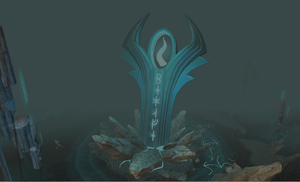
The true history of the God Wars is always somewhat difficult to determine. Having occurred several thousand years ago, information about the God Wars is difficult to come by.
However, an even more hindering factor are the differences in accounts of the Wars. Saradominists and Zamorakians often disagree on what truly occurred at the time. For instance, Saradominists such as The Wise Old Man state that when victory was nearly Saradomin's, he pitied the Zamorakians and allowed for a truce to be made. Zamorakians, however, insist that this was not the case, and have their own beliefs on the matter. Most now accept that it was actually Guthix who ended the Wars.
Another difficult subject are the Edicts of Guthix, which were created by Guthix when he ended the Wars. Some religious groups doubt their existence. Others, however, including many important religious advisors such as Aeonisig Raispher, highly encourage the following of the Edicts. This makes understanding them difficult, and has been the cause of many political disputes since their creation.
Significant occurrences
Known events
The God Wars hosted many historical battles and events that shaped Gielinor we know today. Listed below are confirmed events that took place during the Wars, though there are many others that have long since been forgotten. Note that these events are not in order.
- Bandos arrived on Gielinor.
- Uzer, then the largest city in the Kharidian Desert, was besieged by Thammaron, an Elder Demon and chief lieutenant of Zamorak. Despite the Clay Golems' efforts to save the city, they were defeated and Uzer was destroyed. Thammaron, however, is severely wounded by an elite group of Golems, and he is forced to flee the dimension. The wounds eventually prove fatal. Thammaron's remaining army is crushed by Azzanadra.

- The Dorgeshuun goblin tribe fled after refusing to fight in a battle which they could not possibly win. Trapped underground, they struggled for survival, and managed to build a city known as Dorgesh-Kaan approximately 800 years before the end of the Third Age. A civil war erupted between a republic and a tribal Dorgeshuun faction, but ultimately the republic prevails due to an earthquake that wipes out the opposing army.
- Akthanakos was tricked by Enakhra into her temple, where he becomes imprisoned.
- The followers of Zaros struggled against the fury of the other gods that fought for control over Zarosian lands. Some followers of Zaros were forced to flee into the desert and live as bandits.
- Azzanadra, the champion of Zaros and a powerful Mahjarrat, was brought down and imprisoned in a pyramid. It is suggested that Zamorakian and Saradominist forces collaborated to bring him down, as he was immensely powerful.
- The Wilderness, during the Second Age, was part of Zaros' expansive domain. Upon Zaros' defeat and the beginning of the God Wars, the Wilderness became a centre of warfare as a multitude of races and factions attempt to lay waste to the remaining Zarosians. By the end of the Wars, the Wilderness, which had been a forested paradise, is permanently scarred by the war and barren of all but the most twisted life.
- Lord Lowerniel Vergidiyad Drakan, a vampyre lord, gained control of Morytania because of his assistance in Zamorak's rebellion. Southern Morytania, a lush forest also known as Hallowland, is quickly overrun by Drakan's hordes of werewolves, vampyres, and the undead. Queen Efaritay, the icyene queen of the area, surrendered after her husband, King Ascertes is captured, giving Drakan complete control over the land. He converts the area's cities into large ghettos where the inhabitants are farmed for blood. He captures the castle now known as Castle Drakan and makes it his main stronghold. South-eastern Morytania is renamed the Sanguinesti Region. These events would later lead to the construction of the Paterdomus and the death of six of The Seven Priestly Warriors.
- Count Draynor, the brother of Lord Drakan, set his sights upon the area that is now Draynor Village, although whether he gained control of the land during the Third or Fourth Age is unknown. Once separated from Morytania in the Fourth Age following the blessing of the River Salve, he was greatly weakened.
- The Barrows brothers led forces loyal to Saradomin into the heart of Morytania, seeking to release the land from Drakan's control. They were killed in battle and buried in the Barrows, only to be turned into spirits by the Mahjarrat Sliske.
- The Aviantese, a race of bird-creatures devoted to Armadyl, were wiped out. Armadyl left Gielinor as a result of this. Several were frozen in a massive battle, the God Wars Dungeon, and have recently defrosted.
- Dwarves, after realising that the Wars could force their race to extinction, sealed themselves beneath the world's surface. They constructed their capital, Keldagrim, which exists even to this day.
- The Digsite, known as Senntisten at the time, was destroyed by the forces of Zamorak, but was claimed by Saradominists some years later. The Wars ultimately destroyed Senntisten, and in its place, Saranthium is built. Senntisten was the largest Zarosian city. The construction of Saranthium is known to have taken place between 3740 and 3804 by the evidence on two coins found at the Digsite, the only surviving records of dates from this age.
- Elves retreated into Prifddinas due to the danger of the lands beyond Arandar.
- Gnomes, like dwarves, are forced to flee beneath the surface of the world. Their capital, the Gnome Stronghold, was ruined and remains so until the Fourth Age.
- Mother Mallum, the queen of the Sea Slugs, attempted to conquer the world. She was narrowly stopped by the Saradominist Temple Knights, an organisation which was founded during the God Wars.
- Paddewwa, Kharyrll, Lassar, Dareeyak, Carrallangar, Annakarl, and Ghorrock, Zaros's last remaining fortresses, were destroyed.

- A massive cavern, known today as the God Wars Dungeon, hosted a massive battle between the followers of Bandos, Saradomin, Zamorak, and Armadyl. The cave was hidden during the battle, freezing the combatants. Thousands of years later, in the year 169 of the Fifth Age, the combatants are unfrozen due to tectonic movement in the Wilderness. They resumed their battle as they try to obtain the Godsword.
- The Dagannoths emerged roughly during this time, resulting in great losses for the Fremenniks.
- Bandos led the ogres into the Feldip Hills, quickly wiping out the local populace and claiming the land as his own.
- Wyrms, a species of ancient dragons much more powerful than any known dragon today, slowly disappeared from continued use in combat and evolution. A specific genus of wyrm, the White Dragon, also disappeared.
- Wyverns, a species of flightless two-legged dragons, are believed extinct due to a massive climate shift. Their reanimated skeletons can only be found in the Asgarnian Ice Dungeon, the last remaining place that is cold enough for them to survive.
- Dragon, a type of metal found only in Freneskae and forged by the Dragonkin, fell into the hands of several other races such as humans, fairies, and implings.
- The knowledge of the Ancient Magicks, extremely powerful battle spells, was largely forgotten. Having been used by only a select few Zarosians, their death resulted in the near extinction of these magicks. However, the spells have resurfaced and have fallen into the hands of evil mages such as Solus Dellagar and Zenevivia.
- Contact with an Underwater city was lost, with all memory of the city nearly vanishing from Gielinor. Few now remember it save Guthix himself.
- Amongst the greatest desert cities was Ullek, a settlement found in the cliffs and swamps of the south-eastern desert. Shortly after Uzer was attacked by Thammaron, Ullek was attacked by Balfrug Kreeyath, a 3-faced demon and the future bodyguard of K'ril Tsutsaroth. The few that escaped eventually took refuge in Sophanem, which was a small village at the time.
- The desert deities of the Menaphites, who had ruled the Kharidian Desert for countless years, fell from power, perhaps because of the large amount of combat taking place within the desert. Although they continue to hold sway in areas such as Menaphos, their influence diminishes largely in the outside world, even leading some to doubt their existence.
- Yu'biusk was the original world of the goblins. Here they lived in peace for thousands of years until being discovered by Bandos. Bandos took them to Gielinor, despite the goblins resisting this, leaving their world in ruin. Once in Gielinor, they became his devoted warriors, referring to him as the "Big High War God".
- Nezikchened, a Black Demon of massive proportions, may have been imprisoned in a cave beneath the Kharazi Jungle during this time. Although little is known of Nezikchened, it is likely that he was a servant of Zamorak and was imprisoned by a small group of warriors, most likely Saradominists.
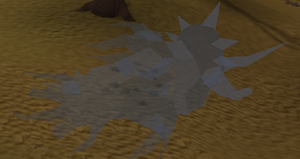
- Many of the thousands that perished in the Wilderness returned from the dead as Revenants. These creatures terrorise the Wilderness even after the God Wars end, their crazed, broken minds filled with bloodlust. Not able to die permanently, these creatures eternally haunt the Wilderness.
- Dragontooth Island, a small forested land east of Morytania, is used by Saradominists as an outpost. They were brutally killed by an unknown enemy, leaving much of their tale a mystery.
- Agrith-Naar, a powerful demon, was banished from Gielinor by Guthix upon his awakening. However, he still managed to influence Gielinor by controlling natural disasters.
- A large island north of Morytania, commonly known today as "Kudos Island", was ravaged by war. Many of the animal species unique to the island are entirely wiped out. These long-extinct creatures are now being studied by the Varrock Museum, and the island itself will soon be reachable via barge.
- The Fist of Guthix was formed shortly after Guthix returns to the surface. The manner in which it was created, though, is debated.
- The town of Eastbridge was destroyed in the intense fighting.
- At some point, Bandos' race of great warriors, the Ourgs, were destroyed.
- The Myriad, an unknown civilization that inhabited the areas of southern Misthalin, were destroyed by unknown forces. The Light creatures are the last thing remaining from that ancient race.
Major conflicts
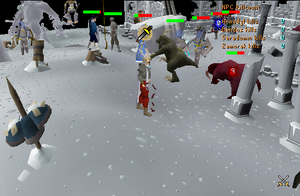
During the God Wars there were thousands of individual battles and conflicts between the people of Gielinor. Although many have been forgotten, some of the more significant ones are still remembered today, such as those listed below. Please note that although these battles are basically in order, there may be some that are slightly out of place.
- The Fall of Senntisten
- The Destruction of the seven Zarosian Fortresses
- The Wilderness Campaign
- The Dorgeshuun Civil War
- The Sea Slug Conflicts
- Fall of Hallowvale
- Morytania Campaign
- The Destruction of Uzer
- Northern Kharidian Desert Campaign
- The Battle of Ardougne
- The God Wars Dungeon battle.
War tactics

The God Wars were a bloody time marred by battles. Because the land was ever-changing from the constant battles which plagued its surface, there were only a few long-standing cities. Occasionally large camps would be created, but rarely did any significant settlement survive for long.
Because of this, the battles of the God Wars were more violent and bloody than any other. Everyone was pushed to fighting; there were very few "civilians". The majority of battles were battles held on open land with make-shift defensive structures placed to protect soldiers. While some armies made use of strategy and cunning tactics to overcome their foes, others chose brute force. Followers of Bandos in particular were known for their strength and brutality. Making use of overwhelming numbers, Bandos's armies took no prisoners.
Equipment
Armour such as this was used often in the God Wars. Far stronger than most metal used today, its resilience made it the equipment of choice for those that could create it. What it is made from, depending on class is white dragonhide, enchanted silk, and enchanted silver, but where it came from is unknown; the art of smithing this equipment was lost long ago. This armour is crafted so well that it can still be used today, and is highly prized amongst those with the funds or the skills to obtain it. This armour was called Third age armour.
Siege weaponry was used primarily during the beginning of the Wars, although it was utilised at times later into the Third Age. To eliminate the remaining settlements, soldiers made use of battering rams, siege ladders, and other such equipment.
Impact on Gielinor today

The God Wars continue to have an impact on Gielinor today. Many of the lands that were seized by certain races in the God Wars are still under their rule today. Many areas, such as the Feldip Hills and Morytania continue to be affected by their roles in the Wars. The wilderness, in particular, has remained virtually unchanged since it was destroyed during the Wars.
The God Wars also serve as a historical reminder to the rulers of the modern age. Since the Edicts of Guthix were put in place, there have continued to be countless battles; indeed, the Fourth Age was a time of great violence between the world's races. The only thing that has prevented these from escalating into all-out wars are the Edicts, which prevent large-scale attacks between different races and religious factions. Rulers must be careful to abide by these. For instance, King Roald III of Varrock is currently faced with a difficult situation; the werewolves of Morytania have begun to kidnap travellers near the Paterdomus to appease the blood tithes of the vampyres. However, the king can not launch a full-scale assault, as doing so could result in another God War and the destruction of the world. Some wish to circumvent the Edicts or remove them completely, including a number of splinter groups currently operating near the Paterdomus temple. The God Wars could be seen as Gielinor's equivalent of nuclear war in the real world, with no apparent 'winners' yet many losers.
Excavations are also being performed in the search for relics from these ancient times. This is a difficult task, however; the God Wars occurred over 4000 years ago, so nearly all of the artefacts from this time have been destroyed. Furthermore, there were few permanent structures during the time, leaving us with little understanding of the architecture, literature, or any other cultural aspects of the age. Fortunately, there is a considerable amount of armour that has survived within the earth, and in some areas pottery and other such relics can be found. The largest excavation currently under way is being performed by the Varrock Museum at the Digsite east of Varrock, which was once the Zarosian capital of Senntisten (and later Saranthium). Other, smaller, digs are also under way, such as the one performed by the Dorgeshuun. Recently, they discovered a large number of artefacts from the Dorgeshuun civil war while they were helping the dwarves to build the Dorgesh-Kaan - Keldagrim Train System.
Trivia
- It is currently unknown as to whether or not Brassica Prime or Marimbo were involved in the God Wars, though Saradomin has claimed all the deities of Gielinor participated.
References
|
First Age • Second Age • Third Age • Fourth Age • Fifth Age • Historical timeline |
